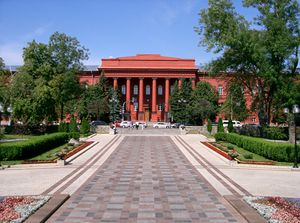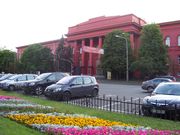Kiev University
| Taras Shevchenko National University of Kyiv | |
|---|---|
| Київський національний університет імені Тараса Шевченка | |
 |
|
| Latin: Universitas Kioviensis | |
| Motto | "Utilitas honor et gloria" (Latin) |
| Motto in English | Utility Honor and Glory |
| Established | 1834 |
| Type | Public |
| Rector | Leonid Huberskyi |
| Admin. staff | 3420 [1] |
| Students | 20,000 |
| Location | Kiev, |
| Campus | urban |
| Colors | red and black |
| Affiliations | IAU |
| Website | www.univ.kiev.ua/ |
Kyiv University or officially the National Taras Shevchenko University of Kyiv (Ukrainian: Київський національний університет імені Тараса Шевченка), colloquially known in Ukrainian as KNU or Sheva (Ukrainian: Київський національний універcитет - КНУ, "Шева") is a major research university located in Kiev, the capital of Ukraine. It is the first formally established modern research university in Kiev and the first national university of Ukraine. Currently, its structure consists of fifteen Faculties (academic departments) and five Institutes.It was founded in 1834 as the University of Saint Vladimir, and since then it has changed its name several times. During the Soviet Union era, Kiev University was one of the top three universities in the USSR, with Moscow State University and Leningrad State University. Today, most national and international rankings frequently place Kiev University as the best universities in Ukraine (see below). Throughout its history, the university has distinguished itself from its peers in terms of intellectual freedom and has produced and hosted many of modern Russian and Ukrainian's top thinkers, including Nikolay Bunge, Mykhailo Drahomanov, Mykhailo Hrushevskyi, Nikolai Berdyaev, Mikhail Bulgakov, Viacheslav Chornovil, Leonid Kravchuk, Oksana Zabuzhko and many others famous names. Kiev University was influential in the birth of 1905 Russian Revolution, Russian Revolution (1917), the Ukrainian People's Republic, Soviet dissidents movement and many other significant events.
Contents |
Reputation and Honors

Kiev University is named after Taras Shevchenko, a major figure in Ukrainian literature and painting. It is an institution of higher education that trains specialists in many fields of knowledge and carries out research. It is considered the most prestigious university in Ukraine[2] and a major centre of advanced learning and progressive thinking [3]. It consists of more faculties and departments and trains specialists in a greater number of academic fields than any other Ukrainian educational institution.
In 2009 Delovoy magazine ranked Kiev University as the first best university in Ukraine, being nationally the strongest in a greater number of academic fields [4] According to the independent ranking of 228 universities in Ukraine performed by Compas, Kiev University was ranked the first best position in Ukraine regarding the adequacy of alumni to the labor market of Ukraine.[5] According Scopus (2009) Kiev University has the highest research paper output of any Ukrainian university, and is also the top research producer (as assessed by total paper citation count) [6] The university features in the Webometrics Ranking of World Universities (2010) at 1,346 out of 8,000 in the world [7], at 63 out of top 100 universities of the Central and Eastern Europe [8], and a leading academic institution in Ukraine [9].
In the Soviet times Kiev University received one Order of Lenin (1959) and one Order of the October Revolution (1984). The asteroid 4868 Knushevia is named after Kiev University in 2002.
History



Pre-history
Kiev University dates back to the first half of the 17th century. The Kyiv-Mohyla Academy, founded in 1632, provided the foundation upon which Kiev University was subsequently built. This Academy, whose history spanned almost 200 years, was the first establishment of higher education in Ukraine. Among its students are many prominent figures of Ukrainian cultural development: Meletius Smotrytsky, Feofan Prokopovich, Hryhoriy Skovoroda, and many others.
For many years it was realized that the city of Kiev needed a new type of university. Pressure on the authorities to allow the creation of such a school was growing, but it took many decades before this idea was realized. Since the Russian autocracy feared the new school would turn into a centre of Ukrainian national liberation activity, one must say that such fears were not at all groundless. Kiev University did become a focal point of national consciousness.
Saint Vladimir
The University was founded in 1834 and named after Saint Vladimir, the ruler who Christianized the Kievan Rus', when the Emperor Nicholas I of Russia signed the Charter about the creation of the Kiev University named after Saint Vladimir. This name was chosen by the authorities of the Russian Empire, where the role of Orthodox Christianity was immense, and may have reflected the ongoing importance of Kiev as the cradle of Eastern Christianity for the entire Empire.
Kiev University becoming the third oldest university in Ukraine after the University of Lviv and Kharkiv University. The first 62 students started their studies at the university in 1834, in its one faculty, the Faculty of Philosophy, which had two Departments: The Department of History and Philology and The Department of Physics and Mathematics. There were new additions to the original department in 1835 and 1847: the Faculty of Law and the Faculty of Medicine. Later on, the original Faculty of Philosophy was divided into two separate units: the Faculty of History and Philology and the Faculty of Natural Sciences. There were no more additions to the number of departments until the 1920s.
The walls of the main building are painted in red while the tops and bottoms of its columns are painted black. Tsar Nicholas I ordered the entire main building painted red in response to student conscription protests during World War I to remind students of blood spilled by Ukrainian soldiers.
Taras Shevchenko
In 1939, Kiev University was re-named after Taras Shevchenko. Upon graduation from Imperial Academy of Arts in Saint Petersburg, then the capital of the Empire, Taras Shevchenko returned to Kiev, and between 1845–1846, was employed by the Archaeological and Ethnographic Commission at Kiev University until his arrest in 1847.
Notable members
Today
Nowadays, as it has done throughout its history, the University retains its role of a major center of learning and research as well as an important cultural center. Its academics and students follow the long-standing traditions of the highest academic standards and democratic ideals.
At present, the student body of Kiev University totals about 20,000 students; this number includes almost 2,000 students at the Institute of International Relations which is attached to Kiev University.
As training highly qualified specialists has always been the main goal, the faculties and departments constantly revise their curricula and introduce new programs. A number of faculties offer 4-year Bachelor’s and 2-year Master’s Degree programs, together with traditional 5-year Specialist Degree programs. Currently the stress is on student's ability to work independently and meet employer's requirements, thus practical experience in the field being of foremost importance.
The curricula of all Kiev University faculties are based on the combination of academic instruction with student's research work and the combination of thorough theoretical knowledge with specific skills. Having acquired theoretical knowledge in the first and the second year, in their third year undergraduates choose an area to specialize in. At the same time they choose a field for their independent study, joining elective special seminars; the results of research are usually presented at the meetings of students' scientific societies or at scientific conferences, the most interesting results are published.
Kiev University graduates work in institutes of higher learning, research institutes, in industry, governmental agencies, public organizations and private companies.
Admission to Kiev University is open to both Ukrainian and international applicants.
Since 1960, when the first international students were admitted, over 20,000 highly qualified specialists have been trained at Kiev University for 120 countries. The first foreign students of the Kiev University came from Cuba, Guinea, Indonesia, Ghana, Togo, Nigeria, Cameroon, Benin, Zanzibar, Yemen, Algeria, and Afghanistan. They continued on to became doctors, engineers, agriculturists, diplomats, economists, and statesmen in their respective countries [10]
Kiev University maintains contacts with many universities and research centres throughout the world.
Departments
These are the 15 faculties and 5 institutes into which the university is divided:
- Faculty of Biology
- Faculty of Chemistry
- Faculty of Cybernetics
- Faculty of Geography
- Faculty of Geology
- Faculty of Economics
- Faculty of History
- Faculty of Law
- Faculty of Mechanics and Mathematics
- Faculty of Philosophy
- Faculty of Physics
- Faculty of Radiophysics
- Faculty of Psychology
- Faculty of Sociology
- Preparation Faculty
- Institute of Philology
- Institute of Journalism
- Institute of International Relations
- Military Institute
- Institute of High Technologies
Other institutes
- Astronomical Observatory of the Kiev University [2] (Ukrainian)
- Maksymovych Scientific Library [3] (English)
- University Botanic Garden named after Academic O. Fomin [4] (Ukrainian)
- Kaniv Natural Reserved Park of the Kiev University [5] (Ukrainian)
- Regional Cisco Networking Academy [6] (Ukrainian)
- Information & Computer Centre of the Kiev University [7] (Ukrainian)
- Scientific and Research Department of the Kiev University [8] (Ukrainian)
- Center of Ukrainian Studies [9] (English)
- Ukrainian Physico-Mathematical Lyceum [10] (Ukrainian)
- Ukrainian Humanitarian Lyceum [11] (Ukrainian)
See also
- 4868 Knushevia – asteroid named after Kiev University
- Direct action (trade union)
References
- ↑ "УХВАЛА Вченої ради "Про кадрову політику Київського національного університету імені Тараса Шевченка"" (in Ukrainian). 2009-11-02.
- ↑ "200 of the best higher education schools in Ukraine" (in Ukrainian). Dzerkalo Tyzhnia. March 30, 2007. http://www.dt.ua/projects/top200/59129/. Retrieved 2008-08-09.
- ↑ "Decree of the President of Ukraine about Kiev University". Press office of Kiev University. 2008-05-05. http://www.univ.kiev.ua/ua/geninf/ukaz/#2.
- ↑ "Delovoy from 26.03.2009. University ranking 2009 (Russian)". http://www.dengi.ua/clauses/47005.html. Retrieved 2010-05-06.
- ↑ "Ranking by Compas (Russian)". http://www.yourcompass.org/ratings/all.php. Retrieved 2010-05-06.
- ↑ http://uascientist.ning.com/profiles/blogs/novina-tizhnya-rejting-vischih "Ranking by Scopus (Ukrainian)". http://api.ning.com/files/1sh4va--u0AZgLr4sm-UKb8mWCTprY7OTz0wg0GoyE1-ktX8*wNEXfk-sZHGtKrxgWAfh3*or7l2qxmDGsnAGXGuCL9JeRtQ/RankingUA_Scopus.pdf http://uascientist.ning.com/profiles/blogs/novina-tizhnya-rejting-vischih. Retrieved 2010-05-06.
- ↑ Top 6000 Universities // Webometrics Ranking of World Universities
- ↑ [1]
- ↑ University Ranking in Ukraine // Webometrics Ranking of World Universities
- ↑ The history of Preparatory Faculty
External links
- Kiev University Website (Ukrainian)/(Russian)/(English)
- (Biological Department)
- (Mechanics and Mathematics Department)
- (Radiophysics Department)
- (Physics Department)
- (Chemistry Department)
- (Department of Cybernetics)
|
|||||||||||||||||